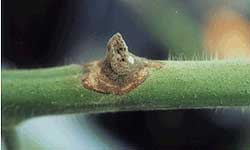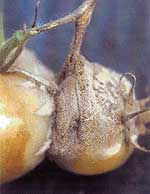Grey mould (botrytis) in greenhouse tomato crops
Grey mould is caused by the fungus Botryotinia fuckeliana (Botrytis cinerea). It is a common and often serious fungal disease of tomato plants (and other plants) in greenhouses and fields.
Once established it's difficult to bring under control and it may be present in greenhouse crops all year round. Severe infection of stems can often kill the plants.
This disease can be a serious problem in post-harvest storage and transport of fruit and vegetables.
Host plants
A wide range of plants can show symptoms of grey mould, including:
- fruit
- vegetables
- ornamentals.
Grey mould can be severe on glasshouse-grown crops such as:
- tomatoes
- cucumbers
- cyclamens
- roses
- chrysanthemums
- carnations.
Symptoms of grey mould can also be found on field-grown crops as well.
Symptoms of grey mould
Grey mould can occur on all above-ground parts of the tomato plant. It often starts at a point of damage or on any decaying tissue. Examples of infection points can include:
- fallen flower petals resting on leaves
- pruning wounds on stems.

The most characteristic symptom is a grey furry mould covering the infected area. This mould is a mass of spores of the grey mould fungus. When shaken, clouds of spores are released from these infected areas.
The infected areas can expand rapidly, covering whole:
- stems
- leaves
- petals.
Stem infections can girdle the whole stem and cause wilting of the plants above the infected area.
Leaf symptoms may appear as a V-shaped dead lesion at the tip of the leaf.
Fruit symptoms can appear as masses of grey furry mould covering parts of the fruit, sepals and peduncles.
Another symptom of grey mould is the production of halo or ghost rings on tomato fruit. These are caused by partial infections that stop developing before the fruit is rotted.

Spread of disease
The source of contamination to a new crop is from spores:
- carried by wind coming from host plants outside the greenhouse
- spread on air currents in the greenhouse.
Environmental conditions
Grey mould infections develop and produce spores under humid conditions. These conditions will also stress the plants, making them susceptible to disease.
Four to six hours of free water on the plant surface is required for spores to germinate and infect the plant. In greenhouses, this usually happens through condensation, which occurs when the plant surfaces are colder than the surrounding air.
The chance of condensation forming increases with high humidity of the air and when the air temperature decreases quickly.
Condensation can also form on the interior surfaces of the greenhouse and drip onto the plants.
Survival of the fungus
In the glasshouse the grey mould causing fungus survives on:
- cut plant surfaces
- dead plant material remaining attached to the plant
- plant debris
- in soil.
It potentially can also survive in organic growing medium.
Controlling grey mould
You can prevent and control grey mould in your greenhouse by combining environmental controls with occasional chemical use. Focus on making sure your greenhouse has good:
- ventilation and air circulation
- plant hygiene and management of infection
- cultural methods.
Don't rely on chemicals as the only control method. Without proper environmental controls, the grey mould will continue to develop and spread.
The fungus prefers temperatures in the range of 18°C to 23°C, but its growth is inhibited by temperatures over 32°C.
Greenhouse ventilation
Provide good ventilation, both day and night, to keep plants dry and air humidity low.
Good air circulation improves ventilation and reduces the chance of condensation forming. Moving air through the crop helps keep the plant and air temperatures the same.
To improve ventilation:
- open the vents in the greenhouse when temperatures rise to replace warm moist air with drier, cool air
- heat the greenhouse at night to reduce condensation (when heated, air absorbs moisture)
- maintain low humidity at night with a cycle of heating and cooling (plant transpiration where water vapour is released at night causes humidity levels to rise in greenhouses)
- install a humidity sensor to allow automatic opening and closing of the vents.
To improve air circulation:
- use fans to move air within the greenhouse
- choose a plant density that will allow good air movement between the plants
- prune regularly to remove laterals, and old and dense leaves to assist air movement through the plants
- avoid leaf wetness by never spraying crops in the afternoon or at any time if the weather is such that drying by night will be difficult.
Plant hygiene
Good plant hygiene can help control outbreaks of grey mould:
- Cut out stem infections and remove dead and senescent plant parts before you begin pruning operations. This will prevent the build-up of spores and the spread of infection.
- Cut out stem infections before the whole stem is damaged to save the plant from dying.
- Remove all plant debris from the previous and current crop – this material carries grey mould spores that can infect the next crop.
- Dispose of these plant residues away from the greenhouse property.
- Avoid having bare soil by covering the floor of the greenhouse – the grey mould fungus survives in the soil and can become a source of infection for the next crop.
- Wash down walls and floors after each crop.
Chemical control
Chemicals can help reduce the risk of infection along with good ventilation and hygiene. Don't rely on chemicals alone to control grey mould. This is because:
- it's difficult to spray all surfaces of the plant where infection can occur
- the fungicides currently registered are protectant types and do not have a systemic action of control
- protectant fungicides only provide a protective barrier to the outside part of the plant that discourages fungal spore development – they don't cure the disease once it has developed
- grey mould fungus is prone to developing resistance to some groups of chemicals products.
The following tips can help with chemical application:
- Use different groups of chemicals on successive sprays to avoid the build-up of strains that are resistant to fungicides.
- When applying chemicals, aim to coat both sides of the leaves and all other parts of the plant. When using high-volume spraying on a full-grown tomato crop, use about 300 litres of spray per 1000 square metres of greenhouse.
- Plan the row spacings so there's enough room between the rows for spraying operations to easily proceed.
- Select a plant spacing between the plants so the spray can be directed at the targeted parts of the plants.
- De-leaf or prune so the sprays can be applied to the parts of the plants that are difficult to reach.
- Consider the use of pruning tools that have an attachment that sprays the pruning wounds with a fungicide.
For spraying to be effective, you must apply the correct amount of product to the crop being treated. Always follow the directions on the product label.
Ensure occupational health and safety for workers when using sprays. Some sprays can cause deterioration of plastic covers.
Cultural methods
Avoid overuse of fertilisers, especially nitrogen.
Reporting an unusual plant insect pest or disease
Report any unusual plant pest or disease immediately using our online reporting form or by calling the Exotic Plant Pest Hotline on 1800 084 881. Early reporting increases the chance of effective control and eradication.
Please take multiple good quality photos of the pests or damage to include in your report where possible, as this is essential for rapid pest and disease diagnosis and response.
Your report will be responded to by an experienced staff member, who may seek more information about the detection and explain next steps.
Report onlineReferences
Commonwealth Agriculture Bureau International. Botryotinia fuckeliana (grey mould-rot) datasheet. Crop Protection Compendium. Last accessed 8 April 2020.
Koike ST, Gladders P, Paulus AO (2007) Vegetable Diseases, A colour handbook. Manson Publishing 448pp.